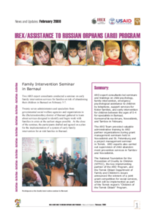Demographic Data
|
Sources: World Bank, UNICEF, UNDP HDR 2015, DHS 2014 |
Displaying 13451 - 13460 of 14391
Examines the institutional challenges in implementing national social protection programmes
These standards were drafted as part of a reform initiative programme in Ghana to ensure that institutional care is used as a last resort
On 13 February 2008 Prime Minister Kevin Rudd made a formal apology to Australia’s Indigenous peoples, particularly to the Stolen Generations whose lives had been blighted by past government policies of forced child removal and Indigenous assimilation.
This report, prepared for UNICEF East and Southern Africa Regional Office (ESARO) assesses capacity of Malawi, South Africa, Swaziland and Zambia to manage alternative care systems for children.
International Social Service’s first segment of the series addresses the historical background and the principles and objectives of the Guidelines
Update on all recent seminars and activities relevant to child welfare reform and deinstitutionalization in Russia
A comparative study on the ethical responsibility of receiving countries of intercountry adoption.
Provides principles of program design and technical recommendations for effective field interventions
Documents the potential hazards and misconceptions surrounding intercountry adoption
Provides insight into the situation of children outside parental care in South Asia, gaps in legislation, capacity, and services, with reference to national and international legal instruments.








